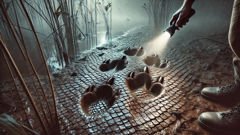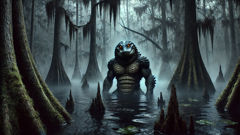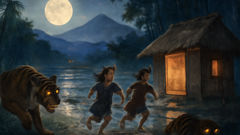Introduction
Dawn never truly breaks over Scape Ore Swamp; it simply seeps in, filtered through thick cypress and a cathedral of Spanish moss. Here in South Carolina’s heartland, where the air hangs heavy with secrets and the ground never feels quite solid beneath your boots, stories grow as wild as the swamp grass. Old-timers and restless teens alike whisper of a towering figure—scaled, emerald, and otherworldly—emerging from the murky water to haunt the backroads that thread through this primordial tangle. It’s a land both beautiful and treacherous: the air is perfumed with decay and wild honeysuckle, dragonflies dart over still pools, and the chorus of frogs is broken only by the low thrum of crickets and the distant cry of a heron. But for generations, one sound has sent shivers down local spines: the sudden, metallic screech of claws raking car doors in the night. The legend of the Lizard Man of Scape Ore Swamp isn’t just a campfire tale. It’s a living, breathing part of the landscape, a cryptid whose shadow stretches from the edge of town to the edge of reason itself. Every so often, headlights flicker and tires crunch gravel, and someone new gets a glimpse—a flash of yellow eyes in the moonlight, the shape of something impossible reflected in a rain-streaked windshield. To outsiders, it’s a curiosity, a tabloid headline. But for those who call Bishopville home, the Lizard Man is as much a part of the swamp as the water itself: a guardian, a warning, and an eternal mystery waiting in the mist.
Whispers Beneath the Cypress: The Legend Takes Shape
Long before the world outside learned the name Scape Ore Swamp, its residents had learned to listen to what moved in the darkness. Generations of hunters, trappers, and fishermen carried stories home from the water’s edge—of strange tracks pressed deep into mud, of ripples in pools where nothing seemed to swim, of guttural bellows that echoed at dawn and dusk. But it wasn’t until the summer of 1988 that those whispers clawed their way into headlines, transforming local fear into national fascination.

It began with a battered Chevy Malibu sputtering along the lonely road just past the intersection of Browntown and Highway 15. Christopher Davis, a young man of seventeen, was just trying to make it home after a late-night shift at the local mill. The air was thick, headlights casting milky cones through the fog. When his tire blew near the edge of the swamp, he pulled over, cursing his luck as the cicadas hummed in chorus. In the hush that followed, Davis heard something moving—heavy, deliberate, dragging through the reeds. What he saw next would become legend: a creature, seven feet tall if an inch, covered in rough, green scales and sporting crimson eyes that burned with cold curiosity. Its three-fingered hands ended in wicked black claws, and its mouth, wide and lipless, flexed with an intelligence that chilled him to the bone.
Davis slammed the door and gunned the engine, but not before the creature’s claws raked deep furrows in the car’s frame. When he screeched into his driveway, he was white as Spanish moss. His parents didn’t believe him until they saw the damage for themselves—the unmistakable marks, too wide for any animal they knew. The sheriff came. The papers came. Soon, so did the cryptid hunters, the news vans, and the curious crowds drawn by the scent of fear and fame.
As the weeks passed, sightings multiplied. An old man tending his still at dawn reported seeing a hulking shadow drink from the creek. A pair of teens on a dare described a shape leaping the road in three impossible strides. A local preacher swore his dog refused to go near certain clearings where the air felt electric and the cicadas fell silent. Each story layered new detail onto the legend—a spiked tail here, webbed feet there, always those burning yellow eyes.
But Scape Ore Swamp is more than just its monsters. It is a world where light rarely penetrates, where the roots of ancient trees lace the ground like the veins of some sleeping giant. Locals say the land itself remembers, and sometimes gives up secrets no one asked for. The legend of the Lizard Man became a kind of shorthand for the unknown lurking at the edge of familiar places. It inspired both terror and pride: schoolchildren drew crayon monsters for art class; the local diner added a “Lizard Man Burger” to its menu. Yet on moonless nights, when the frogs went quiet and something rustled just out of sight, even the bravest souls locked their doors tight.
The sheriff’s office collected reports, measuring claw marks and photographing tracks that disappeared into water. Wildlife experts offered explanations—escaped alligators, misidentified otters, elaborate pranks. But nothing stuck. No one could explain the cars left scratched and dented along lonely roads, or why every story included a chilling sense of being watched. In Bishopville, it wasn’t just about seeing the Lizard Man. It was about feeling him—like a weight in the air, a ripple in the water, a secret you couldn’t quite name. And so, beneath the cypress, the legend grew roots of its own, entwining with every whisper and every shadow that slipped across the swamp.
Shadows on the Water: Encounters and Evidence
By autumn, Bishopville felt changed. The Lizard Man sightings had transformed Scape Ore Swamp into both a pilgrimage site for thrill-seekers and a landmine for skeptics. Local businesses cashed in on the curiosity—gas stations sold ‘Lizard Man Repellent’ (just bottles of colored water), while truckloads of out-of-towners tramped through the reeds, camera flashes strobing like lightning bugs. But beneath the carnival atmosphere, genuine fear lingered like fog.

Officer Samantha Bell was new to the Lee County Sheriff’s Department that year—a transplant from Charleston hoping for quiet work. She found herself assigned to an endless loop of calls: another report of a prowler, another “monster” in the backyard, another tire shredded to ribbons on the edge of the swamp. Bell approached each case with healthy skepticism, but the evidence refused to behave. She photographed tracks as wide as dinner plates pressed into mud. She catalogued hairless, half-eaten muskrats left beside tire ruts. She heard, more than once, the deep croak of something massive moving just out of sight while she walked her patrol at dusk.
The locals had their own theories. Some said the Lizard Man was the spirit of a long-dead Congaree chief, cursed to guard the land after his people vanished into the trees. Others whispered about government experiments gone wrong—a secret lab hidden deep in the swamp, its doors burst open by a hurricane long ago. Children traded rumors about the monster’s lair: a sunken cave where bones gleamed like pearls in the flashlight beam. Skeptics insisted it was nothing but group hysteria or someone in an elaborate costume.
Yet some encounters defied explanation. One night, a delivery driver named Miguel Ortiz cut through the swamp on a shortcut home. He told Officer Bell that he nearly veered off the road when something leapt across his headlights—a creature running upright, its tail flicking, scales shining wet as it vanished into the sawgrass. The next morning, he found his fender dented and a sticky green residue that tests at the local university couldn’t identify.
Theories and sightings collided in town meetings that autumn. The mayor, wary of scaring off hunters and fishermen, urged calm. The local pastor warned of giving too much power to fear. Teenagers dared each other to camp by the water’s edge. Through it all, Officer Bell kept her files—photos, sketches, maps riddled with pins—growing thicker by the week. But when she sat on her porch at night and listened to the swamp’s symphony, she felt a tug of uncertainty, as if something truly ancient was watching and waiting.
By Halloween, Bishopville seemed divided: believers who wouldn’t walk alone after dark and doubters who sneered until dusk fell. But every time a new sighting was reported, even the most skeptical paused before locking their doors. The Lizard Man had become more than a legend; he was now a presence, stitched into every shadow and every chill that rippled down a spine beside Scape Ore Swamp.
The Heart of the Swamp: Secrets and Revelations
Winter in South Carolina is a subtle thing, more gray than white, more fog than frost. The swamp grew quieter as leaves fell and tourists thinned. But for those who stayed, the mystery only deepened. Officer Bell, now considered the department’s reluctant ‘cryptid expert,’ began to piece together a map: each sighting, each clawed car, each echoing roar marked by a red pin on her office wall. Patterns emerged—most encounters clustered along old logging roads, places where water pooled and thick reeds grew high as a man’s chest.

One evening, Bell joined a group of biologists from the university who hoped to capture evidence—be it DNA, droppings, or just a clear trail camera shot. They set up motion sensors and baited traps with chicken and fish. The swamp responded in its own way: nights filled with the splash of alligators, the distant bark of foxes, and, once, a scream that sounded neither animal nor human. When they reviewed the footage, they found only blurred shapes—something massive moving between trees, eyeshine reflecting back in unnatural hues.
Bell’s investigation led her deeper into local folklore. She spoke with elders who remembered stories told by their grandparents—tales of the ‘Swamp Watcher,’ a creature who punished those who disrespected the land. Old Mrs. Jenkins, who lived in a creaking house on stilts above the marsh, told Bell of the night she saw a reptilian figure cradling something in its arms—maybe a wounded bird or a lost kitten—before slipping into the water. Others recalled times when livestock vanished or crops failed, always after someone disturbed a sacred grove or dumped waste in the bayou.
It was in these stories that Bell began to see a pattern: the Lizard Man appeared most often when the swamp was threatened—by poachers, by developers, by outsiders who didn’t understand its rhythms. Perhaps, she thought, the legend had grown from a kernel of truth—a real animal misunderstood and magnified by fear, or a spirit called into being by the swamp’s need for a guardian.
One foggy morning, Bell herself had a brush with the unknown. While checking camera traps near an overgrown logging trail, she heard something heavy moving through the reeds. The air stilled; frogs fell silent. She caught a glimpse of movement—tall, green, shifting among the shadows—and for a split second, met eyes that glowed gold in the dim light. The creature didn’t advance or threaten; it simply watched, then turned and disappeared into a stand of cypress so thick that even sunlight couldn’t follow.
Bell returned to town changed. She told no one but wrote her account in a private journal. In her heart, she believed the Lizard Man was real—not as a monster, but as a warning. The swamp was ancient, older than any town or road, and it kept its secrets close. The legend was its shield, demanding respect from those who might otherwise destroy its delicate balance.
The following spring, construction crews arrived to clear land for a new shopping plaza near the swamp’s edge. Within days, their equipment was found vandalized—paint peeled away by deep gouges, engines flooded with brackish water. Workers refused to stay after sundown. The project stalled, and the swamp reclaimed its ground. Whether it was local pranksters or something else, no one could say. But Bishopville learned to build around Scape Ore Swamp, not through it. The Lizard Man watched on, unseen but never forgotten.
Conclusion
The legend of the Lizard Man of Scape Ore Swamp endures because it embodies everything that is both beautiful and haunting about the land it calls home. For Bishopville and those who wander its backroads, the Lizard Man is more than a cryptid—he’s a living question mark at the intersection of myth and memory, a reminder that some mysteries resist easy answers. To this day, tire tracks still curl along lonely roads, headlights sweep through fog, and people glance nervously at the dark line where water meets shadow. Some seek the thrill of seeing him; others simply respect his domain. Whether he’s flesh and blood or born from collective imagination, the Lizard Man has woven himself into South Carolina’s story—forever watchful in the misty embrace of Scape Ore Swamp.













